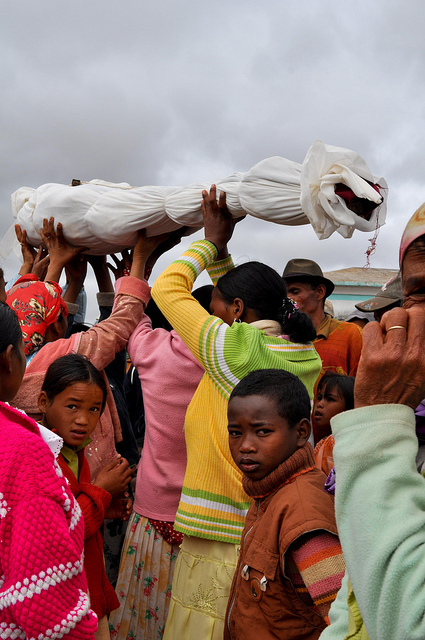Ethnic Burial Customs
/ Malagasian traditional 'dancing with the dead'Last week on the blog we talked about the Parisian catacombs and the mind-boggling six million sets of remains found under the city of Paris. For many people, the sanctity of the original gravesite is paramount and this kind of redistribution of human remains is nothing short of sacrilege. For others, it’s a sensible solution to a real and pressing problem, and every effort was made (and continues to be made) to honour and respect the dead.
Malagasian traditional 'dancing with the dead'Last week on the blog we talked about the Parisian catacombs and the mind-boggling six million sets of remains found under the city of Paris. For many people, the sanctity of the original gravesite is paramount and this kind of redistribution of human remains is nothing short of sacrilege. For others, it’s a sensible solution to a real and pressing problem, and every effort was made (and continues to be made) to honour and respect the dead.
Late last week, Ann sent me a link to a Washington Post article entitled “Reburying the Dead in Guatemala”, concerning the Guatemalan custom of reusing crypts that are no longer supported financially by the family or the community. Crypts are not bought, but leased, and if payments on the lease lapse, paid grave cleaners break open the crypt and remove the remains. If the remains are claimed by the family, they are boxed and put into a central ossuary. If the remains are not claimed, they are bagged in clear plastic with magic marker identifications and added to a mass grave.
Frankly, the article left me gaping. Mummified remains are carelessly manhandled and tossed on the ground. They’re carried under arms like packages and left propped against walls. Bags of remains and uncovered mummies are transferred to mass graves with forklifts. For me, it was the attitude of disrespect for the dead that appalled. But how much of that is simply my societal views of how the dead should be treated? Clearly this is an accepted practice for the people of Guatemala.
It made me think about burial culture and how we as North Americans don’t hold the only proper ideas of how the dead should be laid to rest. Different cultures and different time periods have/had different customs:
- In the Victorian era, before photography became a common tool of the masses, the deceased was dressed in their finest and photographed, often with live family members. This would often be the only image of the deceased the family would ever have.
- Hindus believe cremation is the most spiritually pure way for a human soul to depart. The deceased is burned in a public ceremony and the pyre is lit by the eldest male in the family. The traditional custom of Sati involves the burning of an Indian wife on her husband’s funeral pyre, sometimes voluntarily, often not. Various laws have been passed in different countries, with India finally criminalizing the practice in 1987.
- Cremation is strictly forbidden for Muslims, as is embalming. As a result, burials must take place within only a few days of death. Autopsies are also forbidden unless required by law.
- The Baha’i believe that death is only the beginning of a great spiritual journey. Baha’i dead must be buried within an hour’s travel of the place of death, and may not be embalmed or cremated.
- Several cultures—the Egyptians, the Chinese, and the Vikings—have buried their dead with everything they might need in the afterlife, including sometimes their live servants or wives. For the rich and powerful, this often meant burial sites of great size.
- Sometime the dead are treated in certain ways to protect the living. During the Renaissance, those suspected of vampirism were buried with a stake through their heart, decapitated and buried with their head between their knees, or with a brick between their teeth to prevent biting their way out of their shrouds.
- The people of Tibet traditionally practiced Jhator, or sky burials, where the dead are cut into pieces and left on the top of the mountain for carrion birds to feast on. The practice was both practical and spiritual. Due to the local rocky terrain, the digging of graves for burial was practically impossible, and the lack of trees to provide fuel for fires meant that cremation was not an option. From the spiritual side, the Tibetans believe the vultures are ‘sky dancers’ that will carry the soul of the departed to heaven. The body is simply considered an empty shell after death, so there is no need to preserve it.
- On the island of Madagascar, the tradition of Famadihana, or dancing with the dead, has been practiced since the seventeenth century. Also referred to as the ‘turning of the bones’, it is a celebration, a time for family and friends to gather to reconnect with each other and those who have gone before. The bodies of the dead are exhumed from their tombs and rewrapped in fresh, costly grave cloths. A band plays while the shrouded bodies are lifted up onto shoulders and danced around the tomb before being laid back to rest. Within the community, it’s seen as a way of honouring their family members, and as an act of love.
These are just a few of the cultural traditions around death. Do you know of any others not covered here?
Photo credit: Hery Zo Rakotondramanana



 2.1%
2.1%